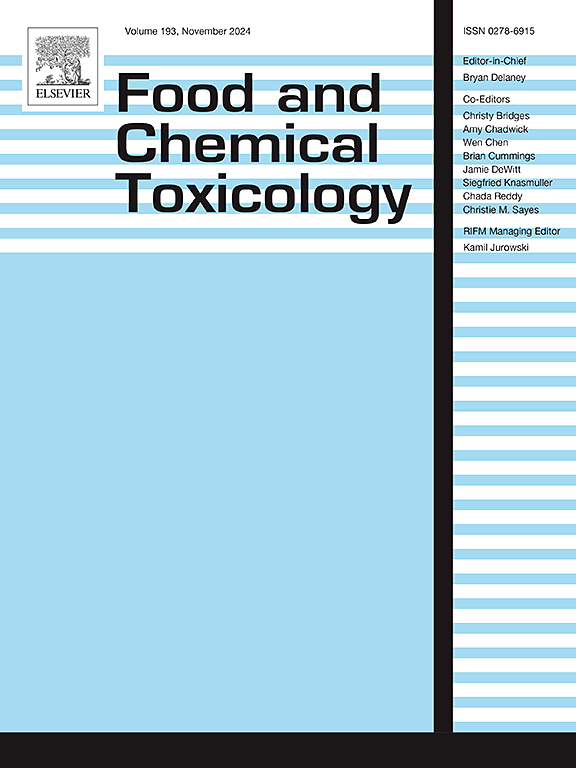PAK1 mediates ivermectin-induced DNA damage in porcine oocytes during meiotic maturation
IF 3.5
3区 医学
Q2 FOOD SCIENCE & TECHNOLOGY
引用次数: 0
Abstract
Ivermectin (IVM), a broad-spectrum antiparasitic agent, is widely utilized in agriculture and animal husbandry. However, the presence of its residues in the environment and food sources may pose potential risks to animal health. Although various cytotoxic effects of IVM have been reported, there is limited information available regarding whether IVM exposure can exert toxic effects on mammalian oocytes. In this study, porcine oocytes were exposed to varying concentrations of IVM for 44 h during in vitro maturation. The results showed that 10 μM IVM significantly inhibited oocyte maturation, as evidenced by the inhibition of first polar body (PB1) extrusion, cytoskeletal disorganization, and meiotic progression arrest. Furthermore, IVM treatment increased expression of γ-H2AX but decreased P21-activated kinase 1 (PAK1) in oocytes, while inhibiting DNA homologous recombination (HR) repair process. Interestingly, these negative effects of IVM were significantly alleviated by the increased expression of PAK1. However, co-treatment with Mirin, an inhibitor of HR repair, reversed the alleviating effect of PAK1 overexpression on oocyte meiotic maturation and DNA damage.
In conclusion, IVM exposure adversely affects the maturation of porcine oocytes and induced DNA damage. Additionally, PAK1 is involved in IVM-induced DNA damage in oocytes, and its mediating role is closely related to the regulation of HR repair.

PAK1介导猪卵母细胞减数分裂成熟过程中伊维菌素诱导的DNA损伤
伊维菌素(IVM)是一种广谱抗寄生虫剂,广泛应用于农牧业。然而,其在环境和食物来源中的残留可能对动物健康构成潜在风险。虽然已经报道了IVM的各种细胞毒性作用,但关于IVM暴露是否会对哺乳动物卵母细胞产生毒性作用的信息有限。在这项研究中,猪卵母细胞在体外成熟过程中暴露于不同浓度的IVM中44小时。结果表明,10 μM IVM显著抑制卵母细胞成熟,表现为抑制第一极体(PB1)挤压、细胞骨架破坏和减数分裂进程阻滞。此外,IVM处理增加了卵母细胞中γ-H2AX的表达,但降低了p21活化激酶1 (PAK1)的表达,同时抑制了DNA同源重组(HR)修复过程。有趣的是,这些IVM的负面影响被PAK1表达的增加显著缓解。然而,与HR修复抑制剂Mirin联合治疗,逆转了PAK1过表达对卵母细胞减数分裂成熟和DNA损伤的缓解作用。综上所述,IVM暴露会对猪卵母细胞的成熟产生不利影响,并引起DNA损伤。此外,PAK1参与了ivm诱导的卵母细胞DNA损伤,其介导作用与HR修复的调控密切相关。
本文章由计算机程序翻译,如有差异,请以英文原文为准。
求助全文
约1分钟内获得全文
求助全文
来源期刊

Food and Chemical Toxicology
工程技术-毒理学
CiteScore
10.90
自引率
4.70%
发文量
651
审稿时长
31 days
期刊介绍:
Food and Chemical Toxicology (FCT), an internationally renowned journal, that publishes original research articles and reviews on toxic effects, in animals and humans, of natural or synthetic chemicals occurring in the human environment with particular emphasis on food, drugs, and chemicals, including agricultural and industrial safety, and consumer product safety. Areas such as safety evaluation of novel foods and ingredients, biotechnologically-derived products, and nanomaterials are included in the scope of the journal. FCT also encourages submission of papers on inter-relationships between nutrition and toxicology and on in vitro techniques, particularly those fostering the 3 Rs.
The principal aim of the journal is to publish high impact, scholarly work and to serve as a multidisciplinary forum for research in toxicology. Papers submitted will be judged on the basis of scientific originality and contribution to the field, quality and subject matter. Studies should address at least one of the following:
-Adverse physiological/biochemical, or pathological changes induced by specific defined substances
-New techniques for assessing potential toxicity, including molecular biology
-Mechanisms underlying toxic phenomena
-Toxicological examinations of specific chemicals or consumer products, both those showing adverse effects and those demonstrating safety, that meet current standards of scientific acceptability.
Authors must clearly and briefly identify what novel toxic effect (s) or toxic mechanism (s) of the chemical are being reported and what their significance is in the abstract. Furthermore, sufficient doses should be included in order to provide information on NOAEL/LOAEL values.
 求助内容:
求助内容: 应助结果提醒方式:
应助结果提醒方式:


